#extant garment
Text
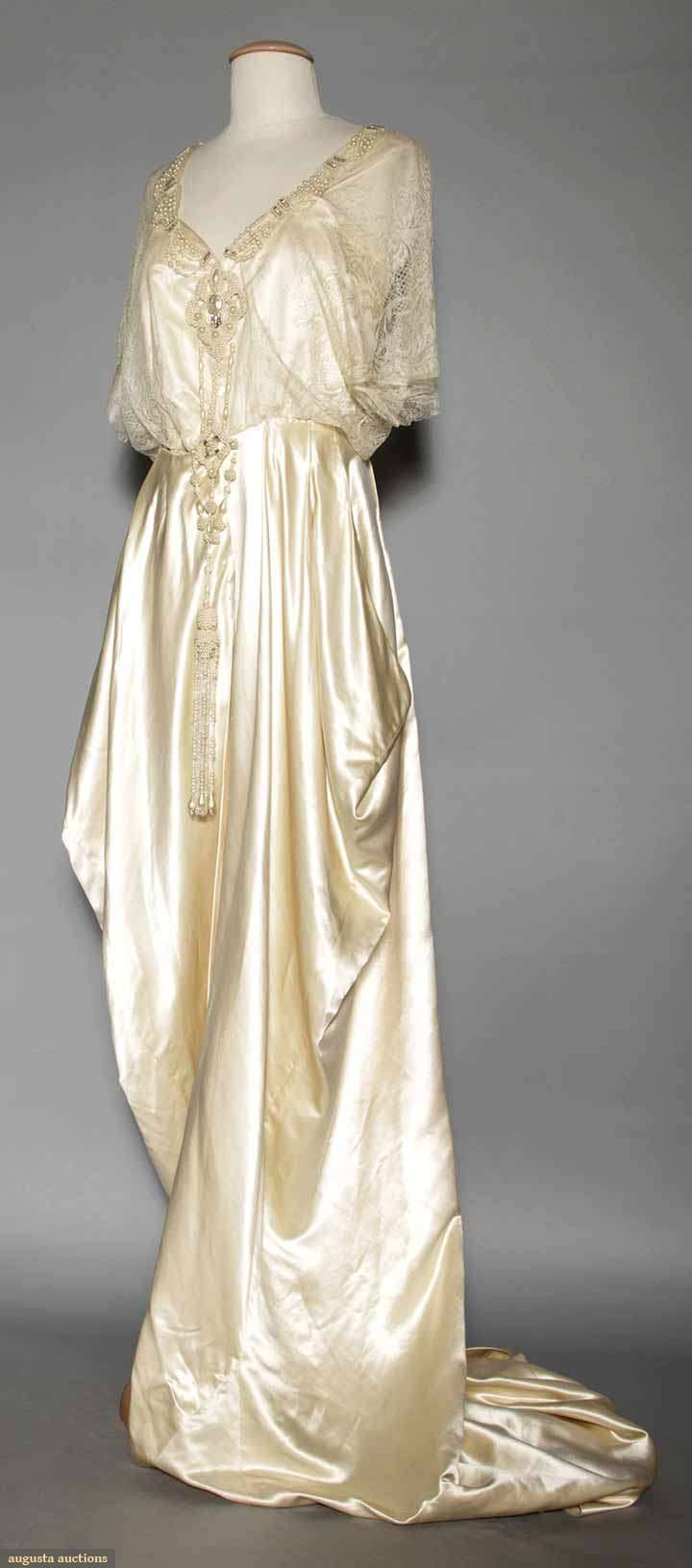

Wedding gown, 1912.
Silk charmeuse trained gown, lace bodice trimmed w/ crystal beads & pearls.
via augusta auctions
#THIS IS HEAVENLY#when i say my jaw dropped#fashion history#history of fashion#historical fashion#history of dress#wedding dress#wedding gown#edwardian era#edwardiana#edwardian fashion#titanic era fashion#titanic era#20th century fashion#extant garment#1910s#1912#1910s fashion#e
350 notes
·
View notes
Note
Hi! I just read your analysis of the P&P 2005 costumes. I'm currently in the process of researching Regency-period fashion for fic purposes; I'm writing a f/f story in a slightly alternate Regency world in which on top of regular marriages, parents (especially in the higher classes) could and did arrange for gay marriages for those of their children who wouldn't inherit - the principle being that the parents could set these couples up with a part of the estate that, upon those couple's death, would revert back to the estate to be inherited onwards, and thus not mess with an entailed estate all that much.
Anyway, long story short, my thought was that in these marriages, there would *still* be a masculine and feminine role, just independent of gender - and there would be according fashions. So, for example, a man's three-piece suit for a woman who took the masculine role in a f/f marriage, just cut towards the female figure, and perhaps with other nods towards the wearer's gender too, and similar for a man who took the feminine role in a m/m marriage.
I just wanted to reach out and see what you think of this and see if you'd have as much fun thinking about this as I have!
Thank you for your message, this honestly sounds really cool!! I think it's very interesting idea to come up with reasoning how arranged same sex marriage would work in a Regency class and land ownership system. I absolutely had so much fun thinking about this, maybe too much fun because look at how long this post is :'D You are entirely free to ignore all of this, I just had a lot of ideas, since your story has such an interesting premise. If you any of this catches your fancy, use it however you like!
I think it makes sense that in a very patriarchal and gender essentialist Regency society the couple would be expected to perform heterosexuality even while literally being in a gay marriage. What you described, men's clothing fitted to women's undergarments, is basically what costumes for breeches roles were usually in theater, roles for female actors, usually as a young leading boy. (Reverse roles, male actors playing female characters, usually elder/motherly roles, were just as common.) Another approach could be to use the women's silhouette, skirt with empire waist, but otherwise the clothing is similar to men's fashion. While most women's Regency styles were particularly strongly contrasted with men's styles, there was quite a lot of masculine styles too, which might work for that purpose.
I think the approach that would make most sense depends on how you want the gnc people seen and understood in the althis society of your story. In Regency society cross-dressing, women wearing pants and men wearing skirts, was seen as stepping into the other gender role. Cross-dressing was not acceptable outside theater, and people who did it needed to be stealth. So if you vision them taking the role of the opposite gender fully and not just in their relationship - living as the opposite gender and treated like that gender (for example the gnc women are allowed men's education and gnc men are not etc.) - I think it makes more sense that they would be using similar clothing as the costumes of the cross-dressing roles in theater. In that specific position it would then become acceptable to cross-dress. But if you envision them more in the societal positions of their own/assigned gender, and just embodying some opposite gender roles, especially in their marriage, I think it might make more sense for them to use the basic silhouettes of the fashion of their gender but in style the opposite gender.
So if you're interested, here's some historical styles and some additional ideas that could work as inspiration.
Before Renaissance men and women's fashions were not separate, but they started drifting apart when wearing skirts became unacceptable for men (which I have a whole long post about). However, very quickly women's fashion started to take influence from men's fashion for certain styles. Riding habit was the first one of these masculine styles for women. It originated from 17th century as men's clothing but with a skirt. From very early on men's military uniforms were a huge influence. A distinctive feature compared to other styles is the long trail so when the woman sits on the horse, her legs are not too exposed. Here's some regency examples. First example is from mid 1797-98. The bodice is exactly in the style of men's fashion of the period. Second is from 1808 in a very militaristic style.
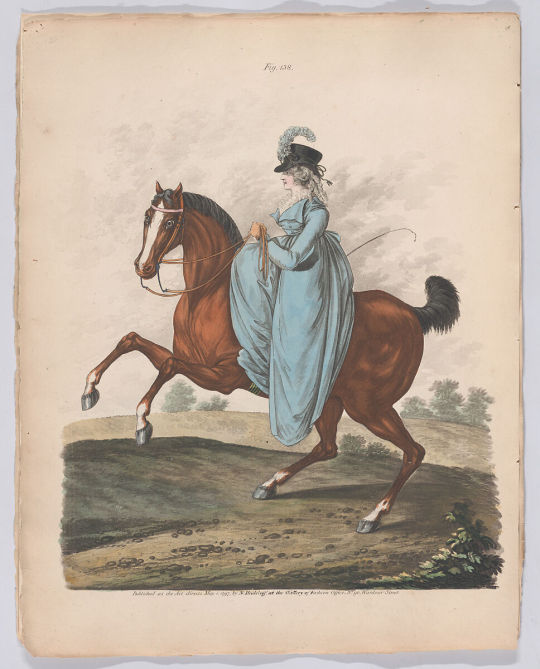
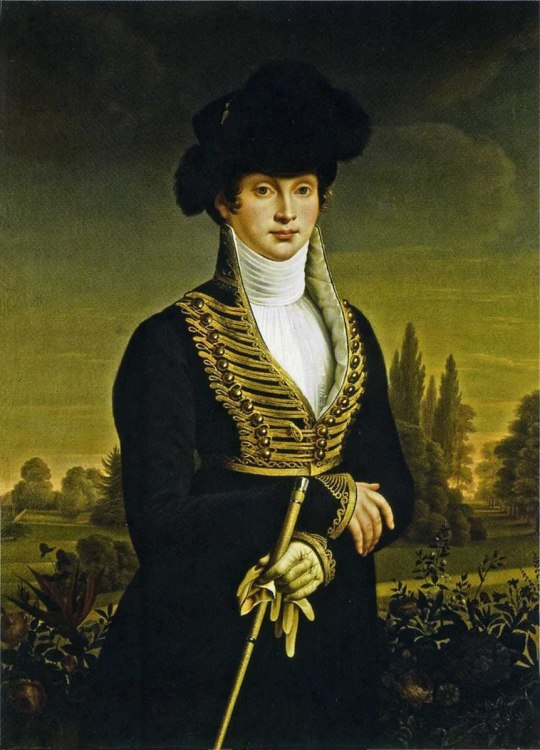
Redingote or pelisse was a long walking dress often in the masculine styles of the riding habit. It was adapted from riding habit to fashionable day wear for outdoors in 1780s. It started as very masculine in line with riding habits, but in 1800s styles without the masculine elements also appeared. Though masculine and military styles were still common. Here's first a redingote from 1800, which follows masculine fashion of the day very closely. The second is from 1810s and has collar from men's fashion and detailing and color are loose references to military styles. The third one is quite military inspired redingote from 1814. It has long train and was probably for carriage rides.
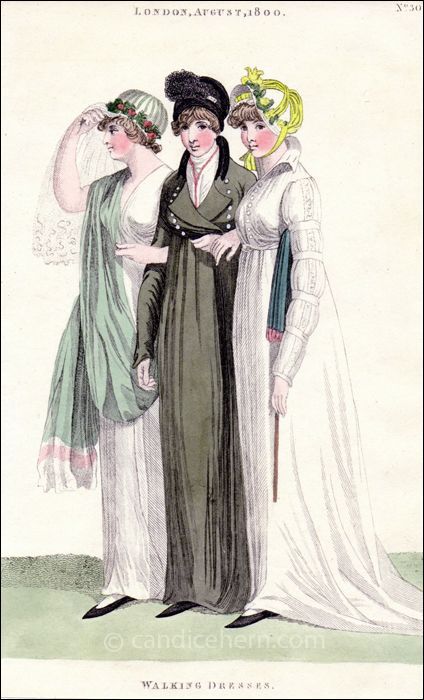


Spencer was a very short casual jacket, modelled after men's fashion again. It became fashionable in 1790s and in the following decades it gained many variations, some not at all masculine in style, and some for formal usage too. Here's very masculine styles as examples, first is from c. 1799, second from c. 1815.
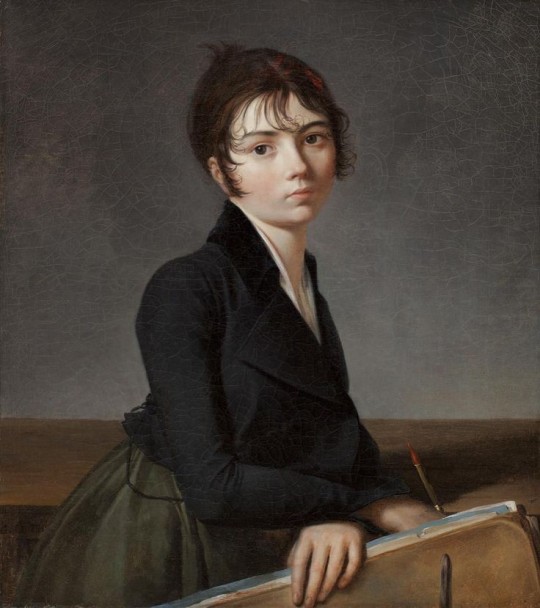

One last trend I'll mention is very short hair imitating Roman men's hairstyles, which became very fashionable for men after the French Revolution, but very similar hair for women became a trend in late 1790s. It was a bold style but for couple of decades it was very popular. I think the woman in the first example above is growing out her Titus cut. There's a little tuft on top of her head, which makes it look like her hair isn't long enough for a bun but secured at the back anyway. Here's couple of actual examples. First is from early 1800s, specific date unknown, showing a slightly longer than usual version of the style. Second is from around the same time, 1798-1805, displaying very well how hair was cut to imitate side burns, which were fashionable for men. The third example from 1809 has the typical cut, where it's very short in the back of the head and little longer and curled in the front.


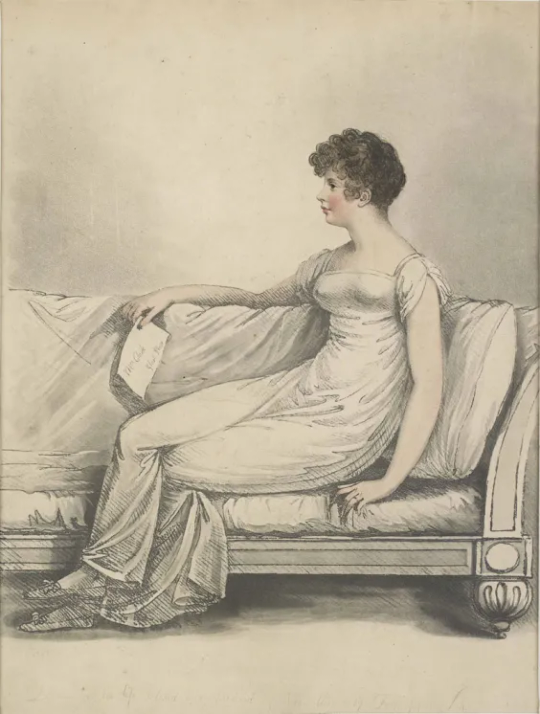
Many Regency sapphics did favour these styles, since they were acceptable ways to present in a more masculine manner. Anne Lister, perhaps the most famous Regency lesbian, presented very masculinely in her portraits. Below her outfit looks like a redingote in this 1822 painting. An infamous upper class Irish sapphic couple, Eleanor Butler and Sarah Ponsonby, lived together for decades in Whales. Here's an illustrations of them from 1818 in their older age wearing masculine redingotes and sporting Titus hairstyles.
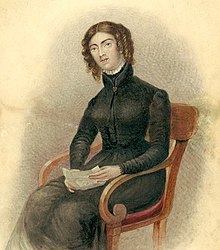

I think in a society where gnc queer people are part of the system, they might have their own slightly different dress codes. For the gnc women/afab people I'm thinking their evening dress might have redingote or spence or perhaps open robe in style of men's evening wear which was black with white cravat (second image below). The open robe could be something like the first image below but fully black, tailored, with large lapels, high collars in the white chemisette and white cravat.


Men's gnc fashion is much harder problem since femininity in men was much less (and still very much seems to be) accepted than masculinity in women. I think it's the old patriarchal superiority of masculinity issue (even if women shouldn't break gender roles at least they are "upgrading", while men would be "downgrading"). I think it might be interesting thought to take inspiration from the styles previous to French Revolution. Regency men's fashion (all Regency fashion really) was result of the French Revolution. I talk more about it in this post, but previously manhood and womanhood had only really been fully available for the upper classes and they were based mostly on displays of wealth. The revolutionaries rejected the aristocratic gender construction and instead created their own. It was based less on class and more on the gender (and racial, but we won't have the time to touch on that here) divide. Aristocratic gender expressions were deemed decadent and the bad kind of feminine. (French Revolution may not have been the origins of the Madonna-whore complex, but they certainly cemented it to the public conscience.) That's how men's Regency fashion was stripped out of colour, detailing and luxurious materials, the overt displays of wealth. New masculine styles were all about evoking militarism, country side and practicality of a working man. Most of it was aesthetic and the class structure remained, but altered heavier in the lines of gender and race/ethnicity. To show you how the fashion was seen, here's couple of satirical cartoons both from 1787 literally calling men wearing the more courtly flamboyant styles women. (First source, second source.)
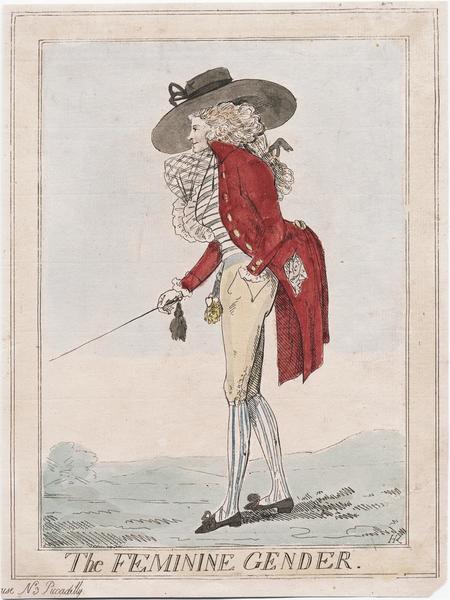

It's not entirely unrealistic that the outdated fashions would remain along the new styles. Courts were resistant to change (especially since the change had anti-monarchist implications) and upheld the outdated dress codes, so court suits were very much continuation of the fashion prior to the revolution (though court suits too started to become increasingly subdued by the 1820s). Here's examples from 1805 and 1813.

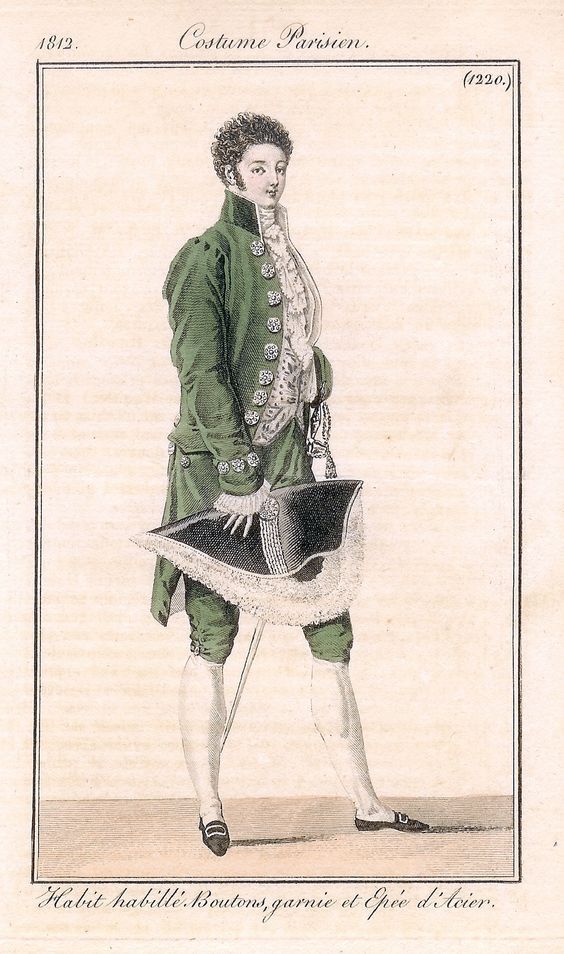
In an alternative historical world like this, I think the pre-revolution styles might have kept on and evolved as a more feminine version of the more general men's fashion. Since masculinity had been tied with rural areas and working class, I think the gnc men's style wouldn't have lapels or turned down collars, which originated from working class clothing, but upward collars like in the 18th century dress coats and Regency court suits (maybe downward collars in informal coats, but not lapels). Maybe they would keep on with the long hairstyles where they tie up their hair with a ribbon, though I don't think they would keep powdering the hair as it went out of fashion for women too. Instead they might style the front of the hair similar to women by cutting hair shorter in the front (basically a mullet) and curling the front of it to frame the face. I don't think they would be wearing the loose trousers, which were very strongly working class till the beginning of 1800s, when they started to be accepted as informal wear for upper class men. Though I think pantaloons would become informal part of feminine men's fashion after general men's fashion would start accepting them as formal wear around 1810s. Here's some examples from 1780s, which could be used as inspiration. First is from 1785-1790, second is from 1788 and the third is from c. 1770.

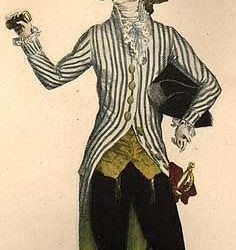

Dress coats were used still in the Regency era not just in court suits but also in morning dress. The cut and silhouette of men's fashion changed after the 1780s, most significantly with the shorter waistcoats. Here's couple of morning riding dresses (they have riding boots) from 1801 and 1806. I envision the feminine men's style as using the fashionable cuts and silhouette of the day, but combining them with the less structured and finer fabrics, patterns, colours and embelishments of pre-revolution styles. In evening wear I think they could wear white, like women, or at least light colours.
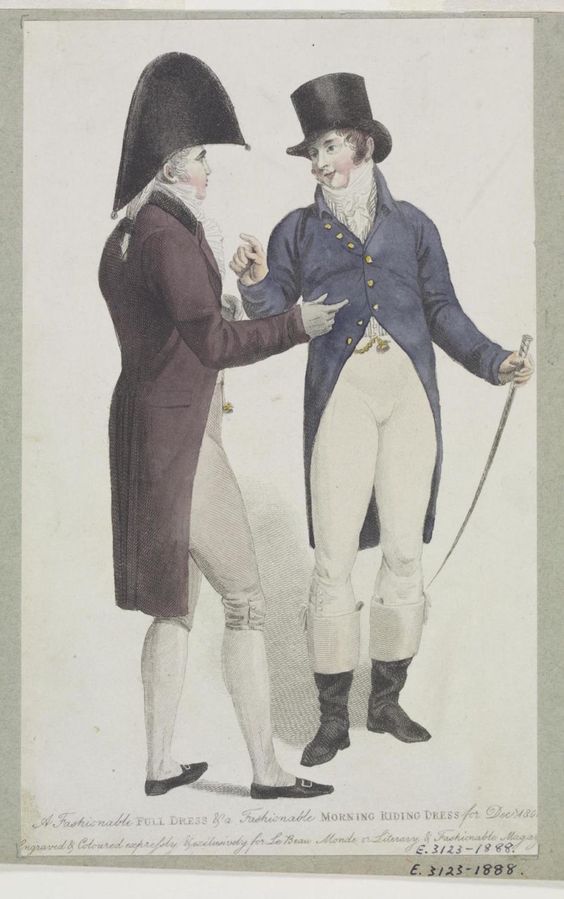
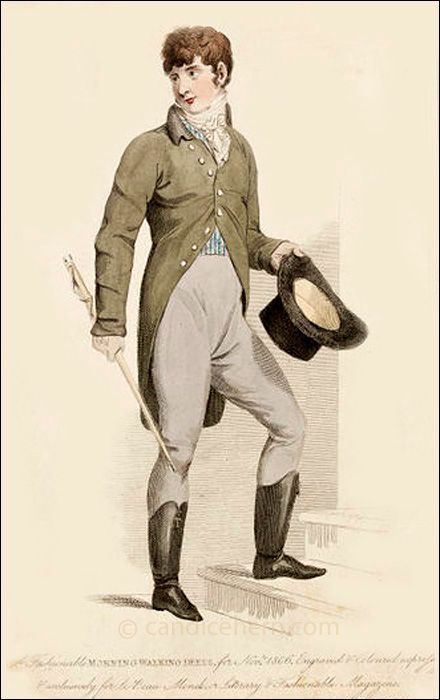
Okay, here's finally all my ideas, I had much more of them than I initially thought! It was so much fun to think about an alternative history like this, so thank you very much for your ask! I hope you found this fun or interesting to read at least, but please take my ideas as just my opinion and if any of it contradicts your vision, just ignore it. It's fiction and an alternative universe in addition so you can follow history just as much or little as you like.
Basically, your story sounds very cool, and I wish you good writing!
#historical fashion#fashion history#history#fashion#historical costuming#dress history#extant garment#costuming#regency fashion#fashion plate#painting#answers#queer history
108 notes
·
View notes
Text

Gown of Countess Palatine Dorothea Sabina of Neuburg
olive green silk velvet with gold trim, sleeves with yellow, slashed atlas silk lining, green taffeta underskirt decorated with silver lace
c. 1598
From the burial place of the Counts Palatine of Neuburg in Lauingen, Germany
Bayerisches Nationalmuseum
#1598#1590s#16th century#renaissance#feminine fashion#historical fashion#antique gowns#fashion history#renaissance germany#rennaissance fashion#extant garment
760 notes
·
View notes
Text
i've bought something extravagant and unnecessary.
I bought a blue velvet 1900s housecoat with a cream silk lining. And I proceeded to do a bit of low effort drag. It's sooo soft. I know I'm going to wear this antique to shreds.

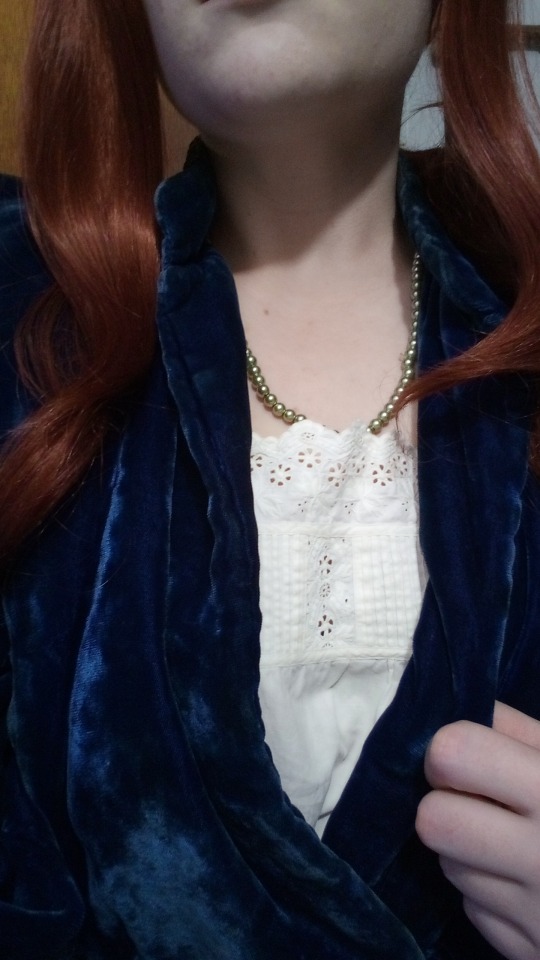
Paired with an equally antique chemise and a red wig, I feel like Rose from Titanic.
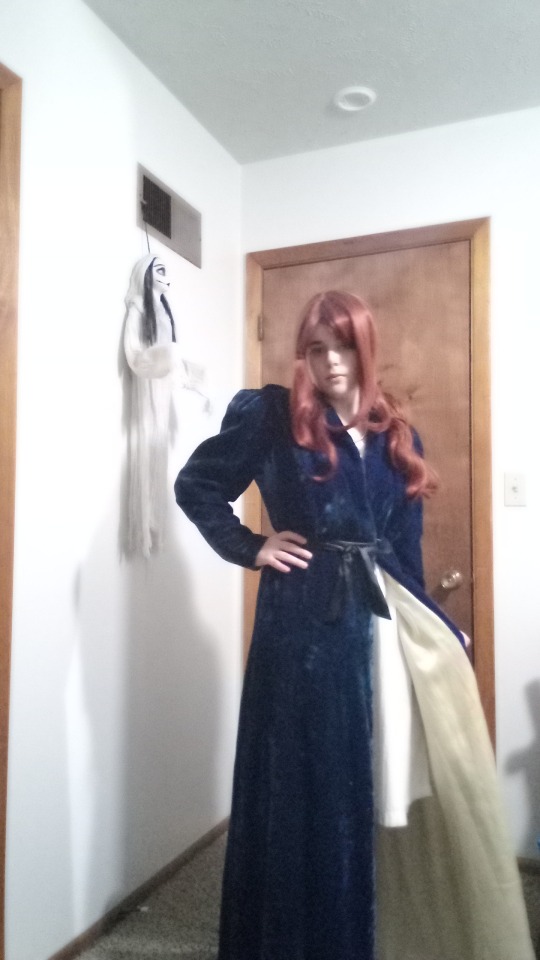
1 note
·
View note
Text
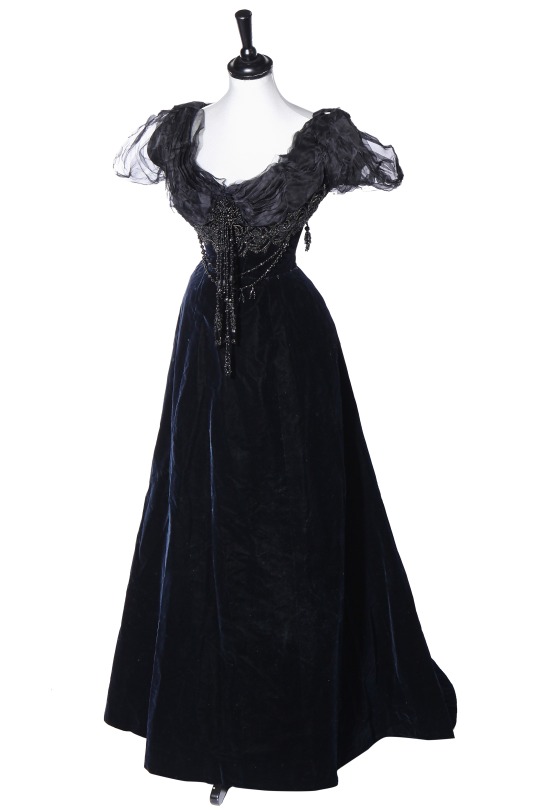


Evening dress ca. 1905
From Kerry Taylor Auctions
4K notes
·
View notes
Text

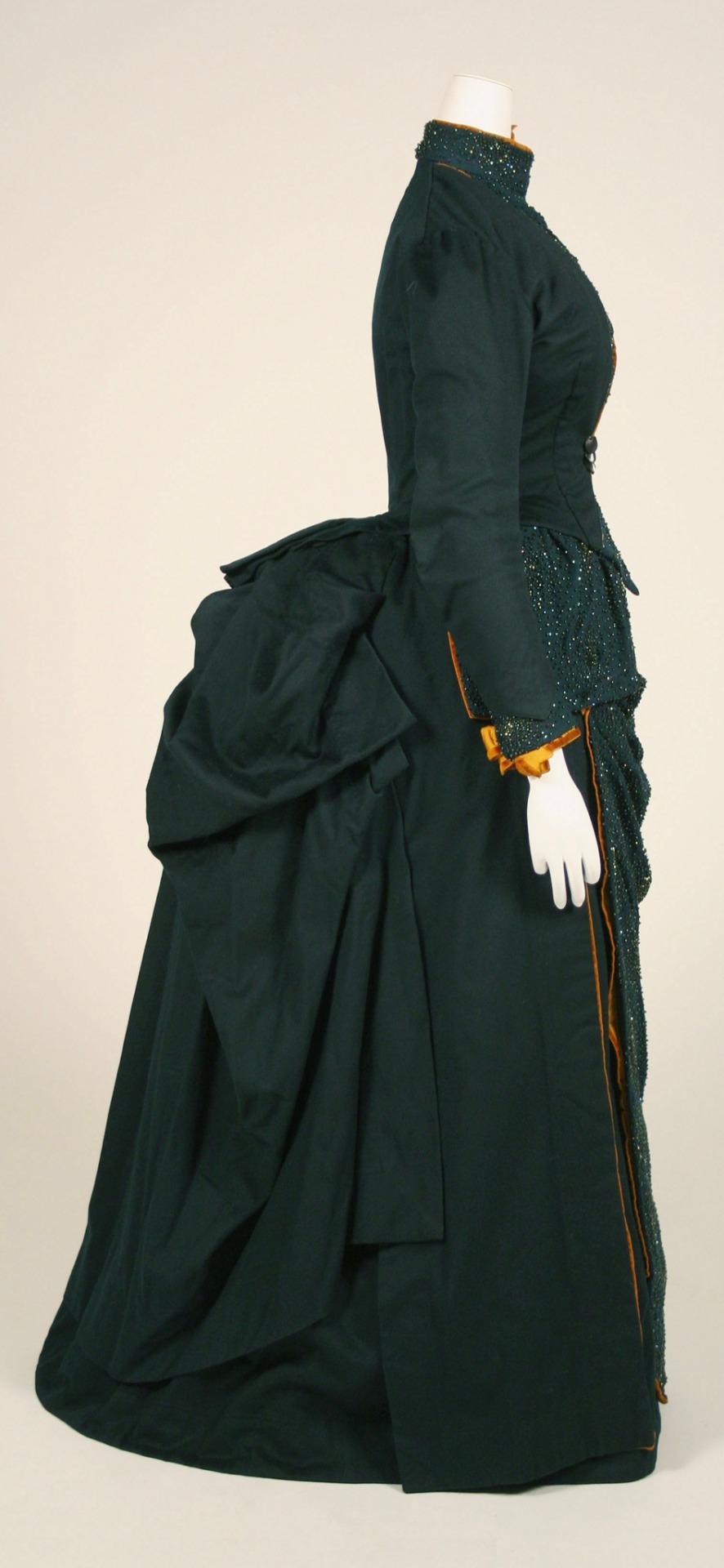

Green wool dress, ca. 1887, American.
Designed by Catherine Donovan.
Met Museum.
#Catherine Donovan#green#womenswear#extant garments#dress#silk#wool#19th century#met museum#usa#1880s#1887#1880s dress#1880s usa#1880s extant garment
1K notes
·
View notes
Text



Met Costume Institute
Walking dress. British. ca. 1830
#fashion history#historical fashion#antique#1800#1830s fashion#1830s#extant garments#met museum#floral#this is my absolute favorite 1830s dress but I don't know if it's been posted before
607 notes
·
View notes
Note
Not sure if it's the same one or just a very similar one, but the dressing gown that inspired yours is currently on display in the Powerhouse museum in Sydney! The colours aren't accurate since my phone likes to oversaturate things :(

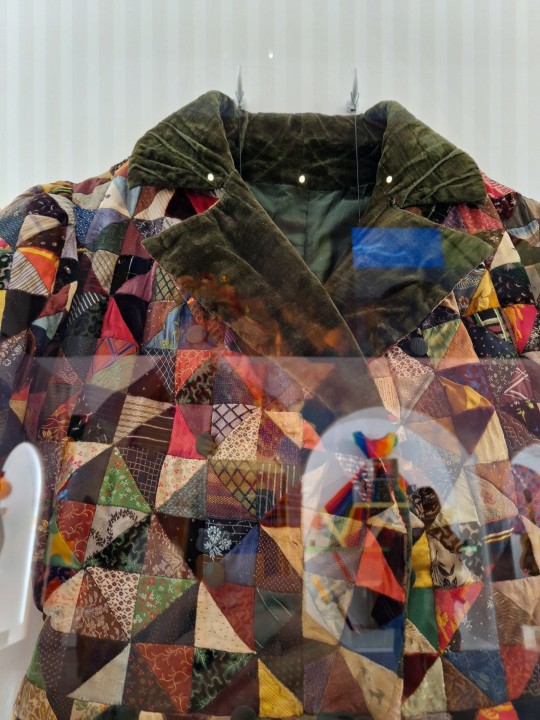
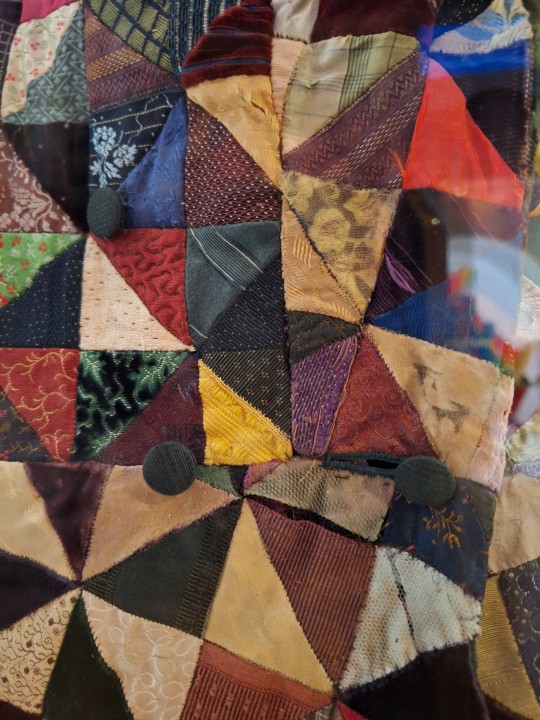
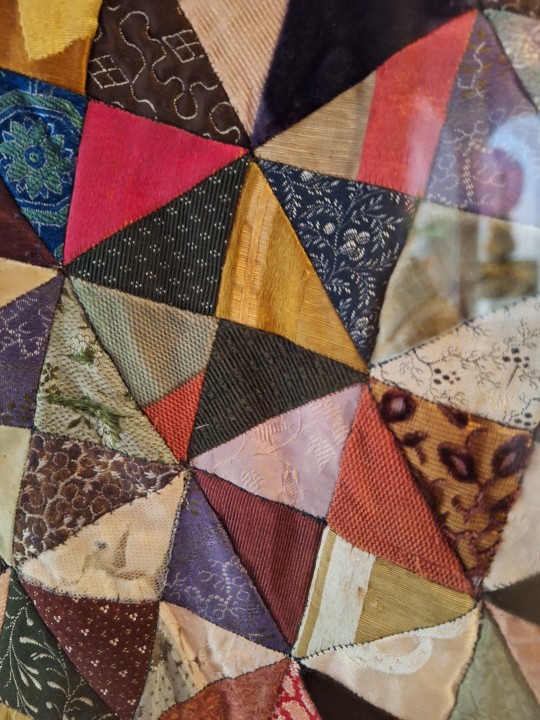
Yes, that's the one!! Thank you for the closeups! It's neat to see that some of the damaged triangles have conservation mesh sewn over them, I hadn't seen that in any of the other photos. So many nice woven textures too.
I suppose I ought to add some pictures of my version for anyone who hasn't seen it.



youtube
814 notes
·
View notes
Text

Extremely rare woman's tie in muslin embroidered with blue flowers and branches. Shaped with Ariadne's thread covered with sky blue silk. Identical choker closed by a hook.
1832-1833
3K notes
·
View notes
Text



Right in the middle of the 18th century, we have this absolutely frothy pink gown that screams springtime. Yellow bows? Sign me up!
If there is a timeless shape, I'm willing to bet it's this one. Though this doesn't have quite the volume of some of the dresses in this period, it still endures again in the 1830s and 1840s, the 1870s and 1880s, and then again in the 1950s. A fitted bodice, a 3/4 sleeve, and a flared skirt. Plus that gorgeous scoop neck.
This robe à la française was owned by Mrs. Maria Altenburg of Denmark. It then had some adventures of its own, showing up later in Victorian Era costume parties! So it's likely it's had alterations. Most dresses of this era have.
I love the floral spill and the ribbon details! Really marvelous on every level. I am obsessed.
Source: https://digitaltmuseum.no/021069530963/overkjole-med-skjort
#fashion history#textiles#costume#historical costuming#silk dress#costume history#threadtalk#history of fashion#baroque#rococo#extant garments#georgian fashion#georgian era
855 notes
·
View notes
Text
God I love the internet.
I’m working on a project and I need to figure out how much lace to buy for the hem of said project and was having trouble mathing said hypothetical hem. I found a fabulous person who made an entire blog post about looking at extant garments measurements or paintings and pictures all the way from before the 1600s to the 1930s and estimating their hems.
I’m a person who needs visuals to be able to picture accurately and this is a godsend. Just needed to find a garment whose hem mimics the project hem and convert the inches into yardage.
#reference#for future reference#fashion#sewing#sew last century#extant garments#historical fashion#thaaaank youuuuuuu
319 notes
·
View notes
Text


Trained Silk Ballgown, c.1912
Silk charmeuse, empire waist, short sleeves, bodice trimmed with cream lace & gold beading, silk illusion draped over-skirt.
first photo via nivifer on pinterest, who I think has lightened it from the original posting.
second photo directly from augusta auctions
#fashion history#historical fashion#history of fashion#edwardiana#edwardian dress#edwardian era#edwardian fashion#titanic era#early 20th century#20th century fashion#extant garment#1910s#1912#1910s fashion#e
185 notes
·
View notes
Note
Hi, while looking through extant garments in a museum collection for reference for a school project, I found several garments of different designs that were all labelled as "binder" without any other context or explanation. Obviously my first thought was the kind of binder I use, especially for the first one that looks elasticated, but I have to assume they're for something else like gynecomastia or compression..? Do you know happen to know anything about them?


This is interesting!
They could actually be the types of binders you use. I immediately thought of 19th century male impersonators - female (?) actors who specialized in male roles in Vaudeville and other similar forms of theater, in which drag was integral part of, and would also have their own one man impersonation comedy and music shows and male stage personas. Basically they were drag kings. (Similarly female impersonators, basically drag queens, were also quite popular.) They were known to bind their chest, and other actors, who didn't necessarily do the impersonation shows, but played male roles on stage, would also often bind their chest for their performance. Here's for example two successful male impersonators, British Vesta Tilley (first picture) and American Ella Westner (second picture).
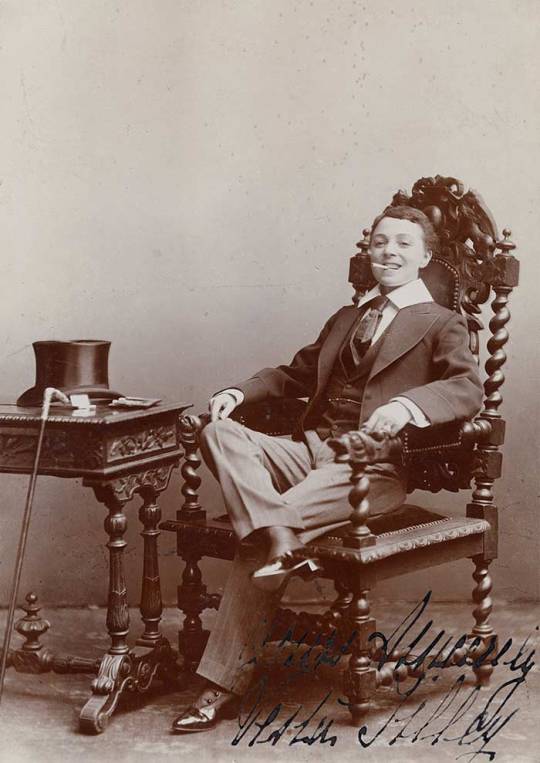
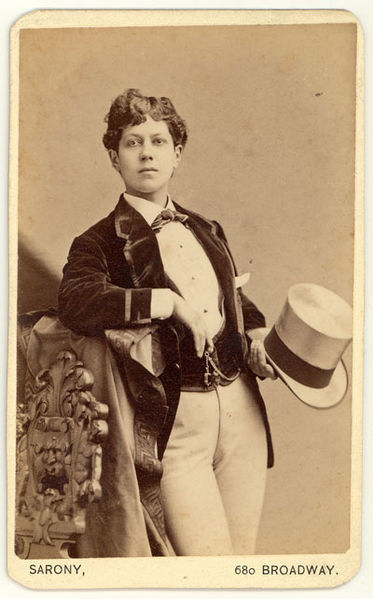

Queer women and trans masc people, who dressed in masculine clothing, (which was pretty common) also sometimes bound their chests, but unsurprisingly that was not exactly celebrated like drag performances were, so there weren't binders made for queer people specifically. I'm guessing they either made their own binders or used binders made for actors. Often those actors were the same people as those queer people, since drag performance was one of the few socially acceptable ways to fuck around with gender. Not all of them were queer, Vesta Tilley looks excellently queer in her drag, but outside stage she was respectable member of high society and very supportive of her husband who became conservative member of parliament (after she had retired). And I think we can easily imagine what kind of political opinions about queer people she was supporting when he was conservative in the context of 1923 Britain. But many of them were known to be queer, like Ella Westner, who eloped to Paris with a very interesting woman, Josie Mansfield (pictured in the last photo above), who was mistress to an infamous scammer and the man who murdered him. Westner was also buried in men's clothing by their own request.
I couldn't find pictures though what did the binders used for chest binding looked like, so I decided to look into what kind of other binders were used in the era. I think the first binder or perhaps both of them could be baby/infant binders (first two pictures below). Apparently people in Victorian era (and in 18th century) believed that chilled abdomen could cause cholera and I guess other bowel issues, so they treated cholera and tried to prevent it by wearing binders and belts (last picture), which could be also made from flannel or wool knit for extra warmth. And babies are quite vulnerable to bowel issues and cholera, so they made binders for babies too. I've seen many different types for these (for both baby and adult use) with some of them like cloth wraps, and some of them kinda corset looking though not corset shaped. If the binders you found were indeed for abdomen warming purposes, I'm sure they are for babies, since those for adults would be so low there definitely wouldn't be shoulder straps like that. The proportions on the first binder especially seem to me fitting for a baby, like the straps feel a bit too wide for adult scale. The second one is harder to guess, it could be a baby binder, but it seems to have boning in the middle, which would make maybe more sense in a chest binder?



But yeah Victorian medicine continues to be... interesting.
#extant garment#historical fashion#fashion history#history#victorian fashion#queer history#undergarments#historical clothing#dress history#historical binder#photography#answers
84 notes
·
View notes
Text
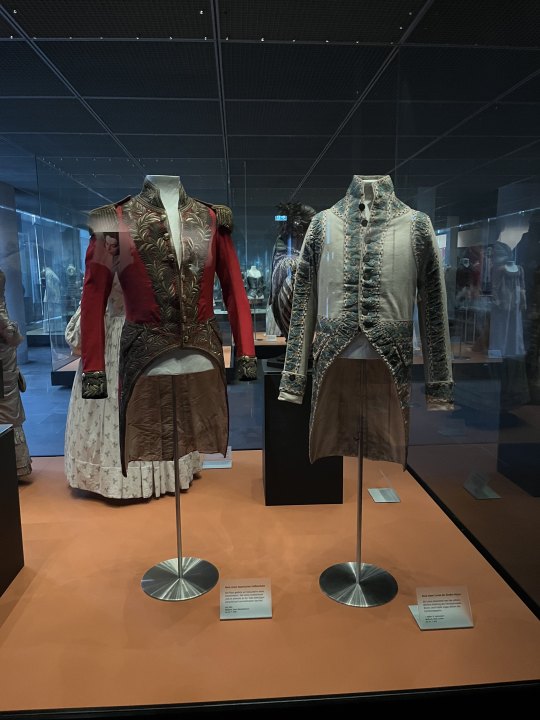
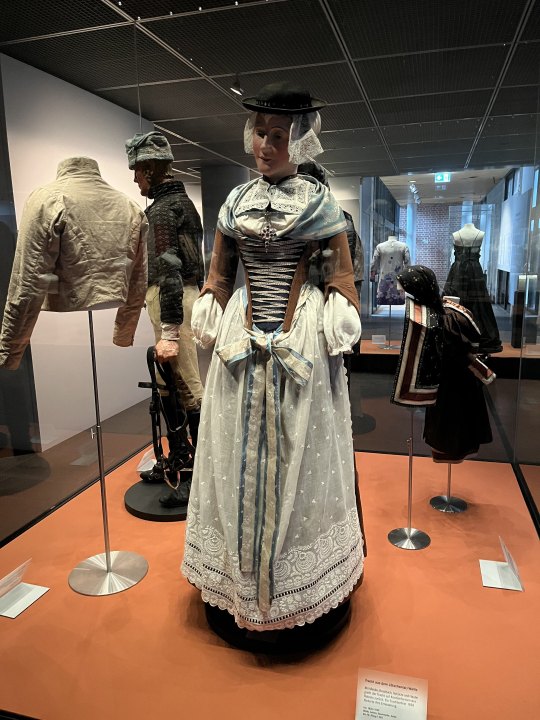

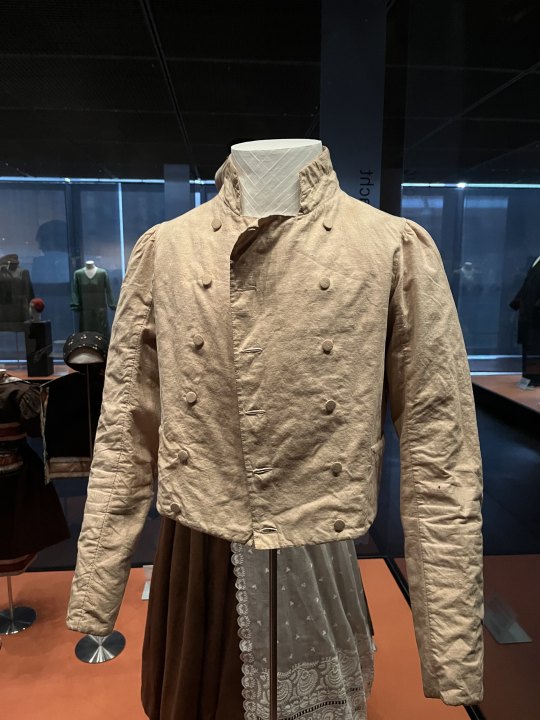
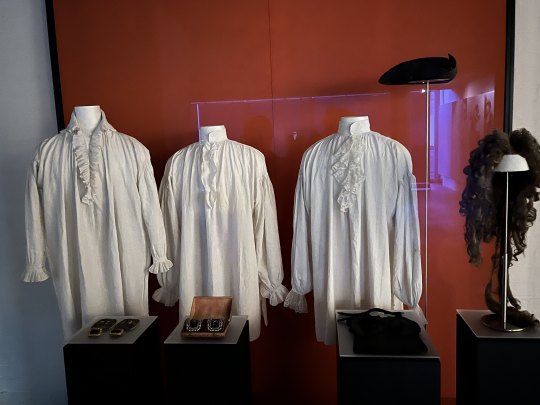



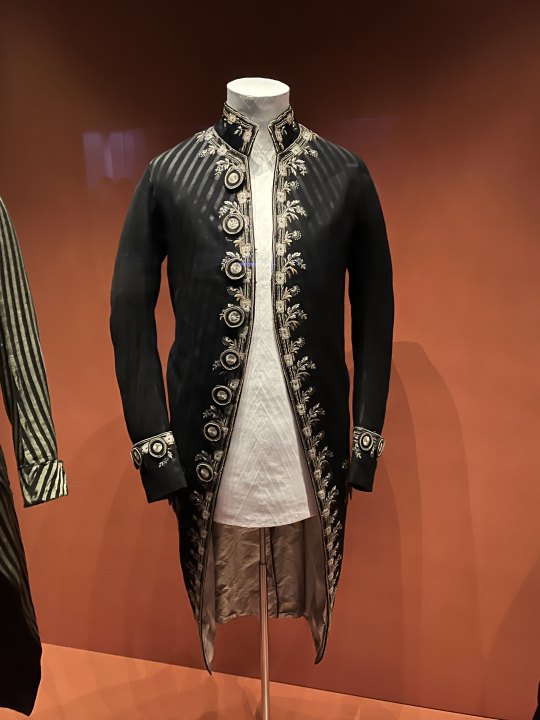

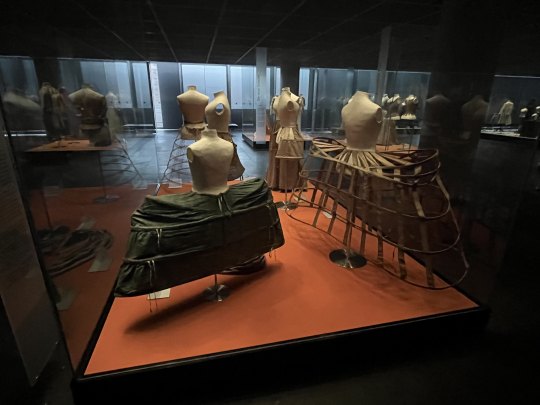
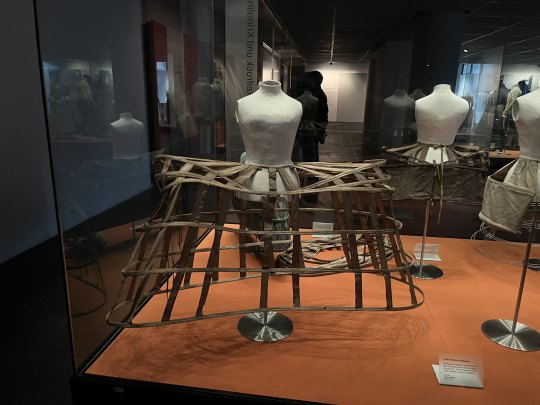
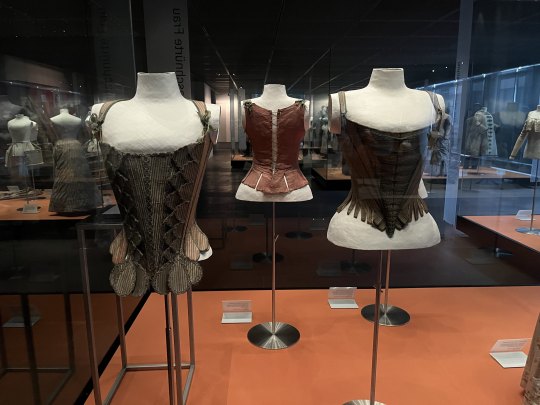

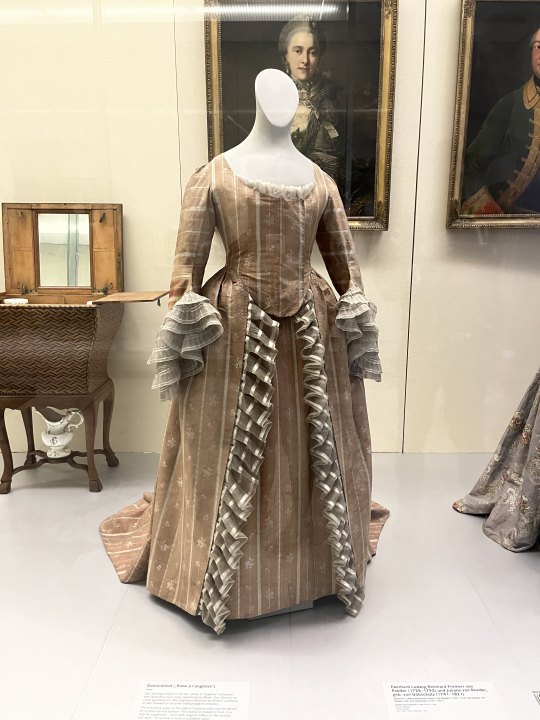
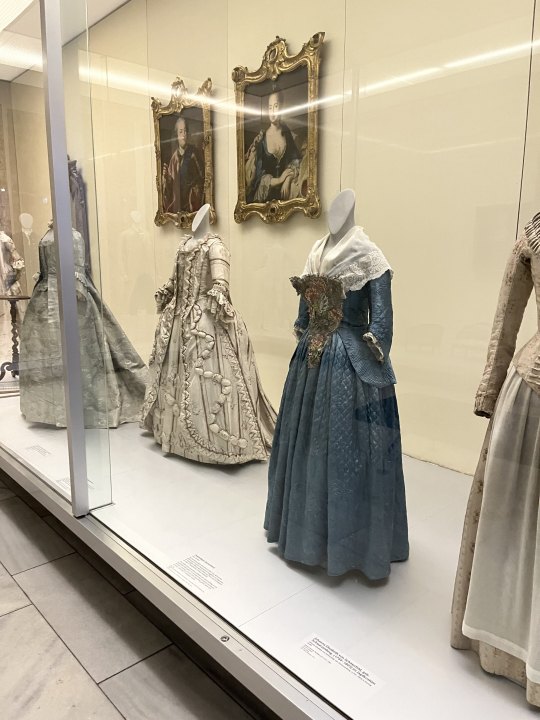
And here, as promised to the dear @vinceaddams come a lot of extant Garments from my recent Visit at the German National Museum in Nuremberg. I am trying to give as much Information about each Picture as I can though unfortunately not all of the Pictures were taken by me and I could take Pictures as extensively (including Info Signs) as I would have wanted, lest I be abandoned in the Clothing Section. Also the whole Section was awfully dim, which made it rather difficult to read some of the Signs. The last three Pictures were taken in a different Section, thus the more pleasant Lighting.
Servant Livery, bavarian Court, mid 19th Century (left); Servant of the Count of Cannotreadhisname, first half 19th Century (right)
Woman's Folkdress, Lötschental/Wallis (Switzerland), Museum dates it 1830/1905 which is an awfully broad Range, but maybe it was altered later; shows wonderfully how late 18th Century Styles were preserved in european Folkdress that came to be in the 19th Century proper
Various Men's Garments throughout the 18th Century, as there are Closeups of each, the respective Detailinformation will be provided further down.
Men's Spencer, c. 1810s-1820s, Linen and Cotton, the Sign didn't say it explicitely but due to it's Placement in the Exhibition and comparable other Pieces I have seen, I think this is more of a common Man's Piece of Clothing.
Three Men's Shirts, various Shoebuckles, a cocked Hat, a Periwig and what I assume to be a Hair Bag. This Display Case had a rather badly illuminated Sign, so sadly I have no further Details about the Pieces.
Justeaucorps, c. 1695, Wool, Silk, Metal Trim.
Waistcoat, c. 1695, Silk, according to the Museum it was worn together with the Justeaucorps, which seems to be a nice Colour-Combination.
Breeches, 1790-1800, Silk. Very pretty Pair, but the bad Lighting doesn't really let it show.
Habit à la francaise, c. 1790, Wool, Silk, Embroidery (What a Material Specification...). I really like the Combination of those subtle dark on dark Stripes and the Embroidery.
Tailcoat, c. 1790/1795, Cotton, Silk, Linen, really peak 1790s Look honestly.
Very wide Court Panniers, with Pocket Hoops and Crinoline in the Background. Alas no Detail Information for this and the next two Pictures.
Frontal View of the Pannier. I suppose I have to get one of those at some Point, if only for how extra they are.
Three Pairs of Stays, two from the Front, one from the Back. Sadly I don't feel confident enough to Date those and I have no Pictures showing the Info Signs well enough.
Lots of pretty Dresses that were exhibited in another Section of the Museum. The right one is a Robe à l'Anglaise, but that's all I can tell.
Another beautiful Anglaise, notable for being preserved in its Entirety with original Ruffles.
More pretty Dresses. Unfortunately due to Time Reasons I have no Pictures of the Suits displayed across the Dresses in the U-shaped Display, though I have to say one of them had a very much not authentic Lacebib hanging from the Neck...
That's all the cool Clothing Pics I have, at some Point I will return and take loooots more Pictures from all the Angles too. Also at some Point I might write to the Museum about the Lighting, there surely is a better Solution when having your Objects barely visible with unreadable Signs while still protecting them from UV-Rays.
Bonus-Pic 1:

Me, in historical Dress, c. 1750 (minus the Shoes), standing in a historical Kitchen.
Bonus-Pic 2, for the Boat-Crowd:
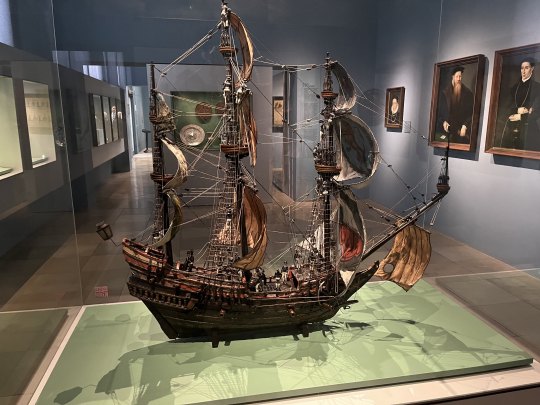
Beautifully detailed Modell Sailing Ship, early to mid 17th Century if I remember correctly. Interestingly enough all the little Sailor Figurines on it were very much early 19th Century in Style, so I assume the previous owner had those added at some Point, before the Museum acquired the Model in the late 19th Century. (The Incongruence sadly wasn't addressed on the Info Sign, so I might contact them about this too.)
#Aus dem Leben einer Taugenichts#Extant Garments#Historical Fashion#Germanisches National Museum#18th Century#19th Century#Museum
156 notes
·
View notes
Text

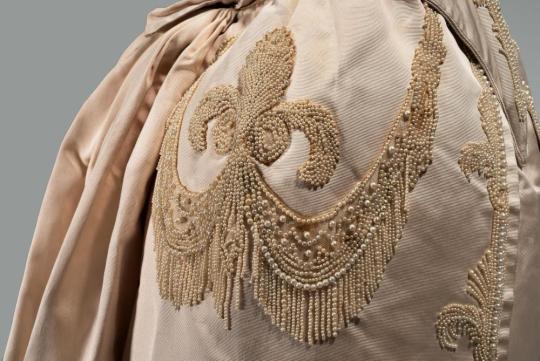
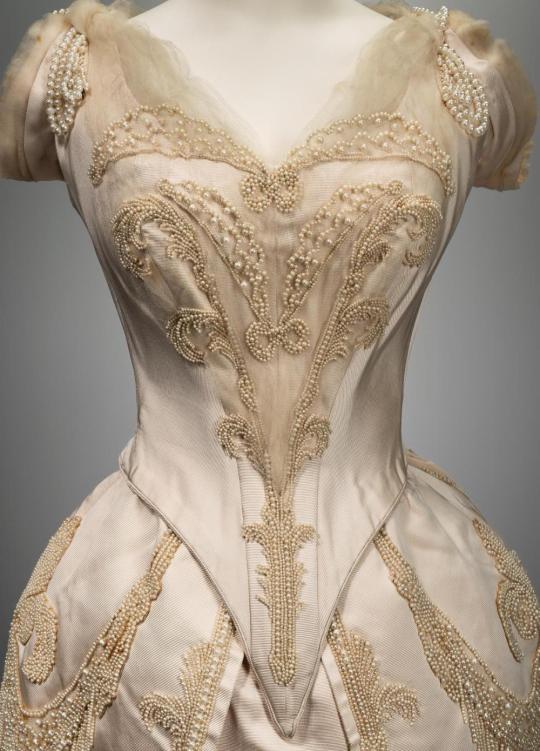
Evening dress by the House of Worth ca. 1880
From MFA Boston
2K notes
·
View notes
Text

Pink Silk Carriage Boots, 1890-1895.
By Marshall Field, Inc.
Albany Institute of History & Art.
#Marshall field Inc.#womenswear#carriage boots#boots#1890#1890s#1890s boots#1890s shoes#extant garments#1890s extant garment#pink#fur#silk#19th century#Albany institute
1K notes
·
View notes